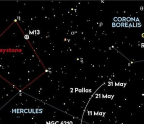
Email us at inbox@skyatnightmagazine.com
MESSAGE OF THE MONTH
This month's top prize: two Philip's titles
The ‘Message of the Month’ writer will receive a bundle of two top titles courtesy of astronomy publisher Philip's: Nigel Henbest's Stargazing 2023 and Robin Scagell's Guide to the Northern Constellations
Winner's details will be passed on to Octopus Publishing to fulfil the prize
Off to a great start
I just wanted to share with you my first deep-sky astrophoto, which I took by following the excellent guide to photographing the Orion Nebula with a DSLR camera on your website, written by Pete Lawrence and David Tolliday (bit.ly/M42DSLR). The exposure time and ISO settings advice was very useful. I used a WideSky 8OS ED refractor telescope on a Sky-Watcher Star Adventurer GTi mount, with aCanon EOS 2000D DSLR camera and the images were stacked in DeepSkyStacker. As I have zero knowledge of Photoshop, I just messed around with it until I got an image I was happy with! Astrophotography seemed daunting to me, but I put the Orion Nebula at the top of my list of goals for this year. To capture it in my first ‘proper’ attempt means I'll be out every clear night snapping away! Please pass my thanks on to Pete and David.






